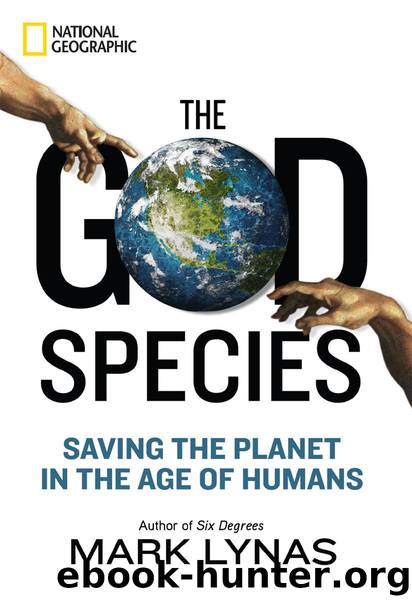The God Species by Mark Lynas

Author:Mark Lynas
Language: eng
Format: mobi, epub
Publisher: National Geographic Society
Published: 2011-02-05T05:00:00+00:00
BOUNDARY SIX
TOXICS
There is perhaps no better illustration of the domestication of our world than how rapidly we are turning it into plastic. Plastics are everywhere. In the deepest ocean trenches, plastic bottles are silently accumulating in thick drifts. Submersibles have photographed plastic bags suspended eerily above the seafloor a mile (1.6 km) below the Arctic ice cap. In other sea areas 10,000 man-made items have been found scattered over a single hectare of the ocean bottom.1 Plastic from the ocean is breaking down and accumulating on beaches: One sand sample gathered from a beach near Plymouth, England, contained 10 percent plastic particles by weight.
In remote islands, seabird populations are being devastated by plastic refuse. On Midway atoll in the Pacific, albatrosses are estimated to feed their chicks a combined 5 tonnes of plastic each year, and 200,000 out of the half-million chicks die each year as a result because of dehydration, perforated stomachs or starvation. Wildlife rangers typically find cigarette lighters, toothbrushes, syringes, toy soldiers, Lego blocks and all manner of other items in dead chicks’ stomachs. “The atoll is littered with decomposing remains, grisly wreaths of feathers and bone surrounding colorful piles of bottle caps, plastic dinosaurs, checkers, highlighter pens, perfume bottles, fishing line and small Styrofoam balls,” reported one visiting journalist.2
The problem with plastic, as with toxic wastes generally, is that the natural world has no way of biologically decomposing artificially manufactured polymers. Humans have now devised countless thousands of novel substances, never before seen on Earth, and released them into the natural environment. Many appear perfectly benign at first pass—but turn out to be very different when they enter the food chain, whether on land or in the sea. Some of the toxics we produce are naturally occurring, like mercury, but human activities mobilize or concentrate them in ways that are potentially devastating to other species and, ultimately, ourselves.
To a large extent the modern environmental movement was founded out of a concern about toxics. Rachel Carson’s seminal 1962 book Silent Spring brought attention to the wanton dispersal of agricultural pesticides like DDT, which she showed were having a damaging effect on non-target species higher up the food chain. Many Green groups including Greenpeace and the World Wildlife Fund have devoted decades both to researching the impacts of toxic chemicals and campaigning for their proper regulation. I have no argument with the Greens here: The movement’s work has by and large been pragmatic and effective. It has also shown a willingness to compromise and to face up to real-world conflicts. DDT, for instance, is important in controlling malaria, and international regulations banning its use in agriculture allow necessary applications to control mosquito populations—exceptions that are sensibly supported by Green groups.
GENDER BENDERS AND VULTURE KILLERS
There is every reason to be cautious about the impacts of toxic pollution. We know that man-made chemicals can have serious and unanticipated impacts on wildlife even at very low doses. In India the numbers of oriental white-backed vultures fell by 99.9 percent between 1992
Download
This site does not store any files on its server. We only index and link to content provided by other sites. Please contact the content providers to delete copyright contents if any and email us, we'll remove relevant links or contents immediately.
| Acoustics | Bridges |
| Earthwork Design | Environmental |
| Fire Science | Highway & Traffic |
| Hydrology | Remote Sensing |
| Seismic Design | Structural |
| Structural Dynamics | Surveying & Photogrammetry |
| Transportation |
Whiskies Galore by Ian Buxton(41935)
Introduction to Aircraft Design (Cambridge Aerospace Series) by John P. Fielding(33085)
Small Unmanned Fixed-wing Aircraft Design by Andrew J. Keane Andras Sobester James P. Scanlan & András Sóbester & James P. Scanlan(32763)
Craft Beer for the Homebrewer by Michael Agnew(18194)
Turbulence by E. J. Noyes(7977)
The Complete Stick Figure Physics Tutorials by Allen Sarah(7334)
Kaplan MCAT General Chemistry Review by Kaplan(6897)
The Thirst by Nesbo Jo(6877)
Bad Blood by John Carreyrou(6581)
Modelling of Convective Heat and Mass Transfer in Rotating Flows by Igor V. Shevchuk(6406)
Learning SQL by Alan Beaulieu(6235)
Weapons of Math Destruction by Cathy O'Neil(6206)
Man-made Catastrophes and Risk Information Concealment by Dmitry Chernov & Didier Sornette(5951)
Digital Minimalism by Cal Newport;(5699)
Life 3.0: Being Human in the Age of Artificial Intelligence by Tegmark Max(5506)
iGen by Jean M. Twenge(5384)
Secrets of Antigravity Propulsion: Tesla, UFOs, and Classified Aerospace Technology by Ph.D. Paul A. Laviolette(5330)
Design of Trajectory Optimization Approach for Space Maneuver Vehicle Skip Entry Problems by Runqi Chai & Al Savvaris & Antonios Tsourdos & Senchun Chai(5036)
Pale Blue Dot by Carl Sagan(4949)
